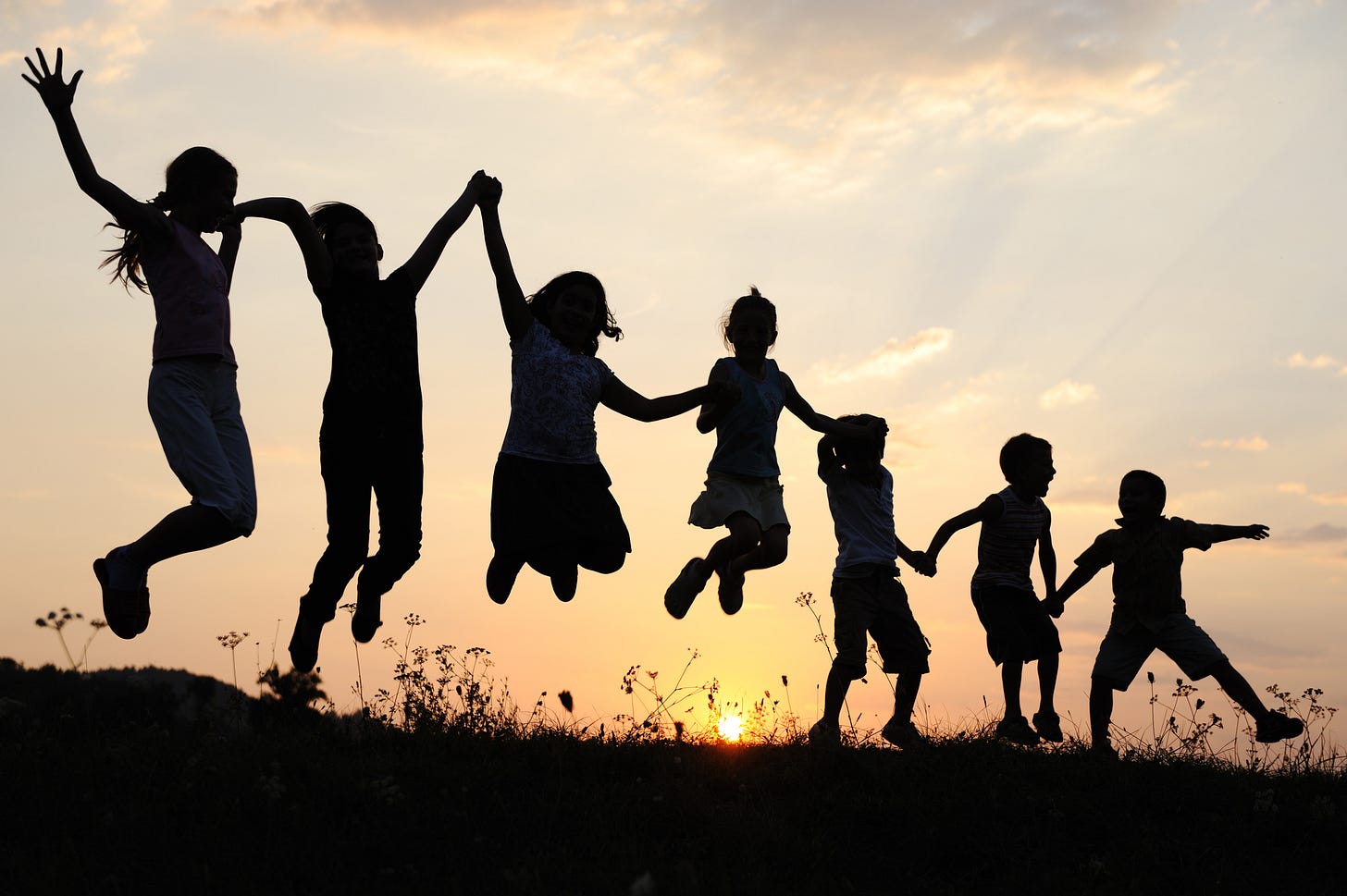LET'S MOVE! Why Getting Kids Active Matters
Compelling kids of all ages (including ourselves) to regard new experiences as an integral aspect of life, as opposed to threats to be avoided, will positively impact physical and mental health.
Last week, NYC’s vaccine mandate for public school extracurricular activities was finally dropped and all kids, for the first time in two and a half years, could play sports, music and perform in school plays. This is a cause for celebration. Throughout the lockdown and well beyond, kids have been restricted in every imaginable way- from socialization, outdoor activity (even playgrounds and basketball courts were closed in NYC, Los Angeles and many other areas during the first months of the pandemic). We kept waiting for Michelle Obama - or anyone! - to speak out (remember “Let’s Move”?) as kids gained weight, became more depressed and even damaged their eyes from technology overload. This is why it is such a joy to bring you Jordana Kagan’s essay on the importance of restoring our children with sports and movement.
Read on and let us know what you think!
Leap to Learn: Movement and Cognition, A Missing Link
by Jordana Kagan NSCA–CPT
Humans grow through movement. Physical activity stimulates the body and enhances the mind. Charles Dickens was famed to walk anywhere between twelve and thirty miles each day. Albert Einstein and Ludwig Van Beethoven were also habitual walkers, and it served them well.
When I studied trigger point therapy back in 2014, my instructor loved to emphasize the role of movement in human development. He was exuberantly excited by the notion that traversing new territory increased our ancestors’ brain power. Back then, the necessity of observing, retaining, and synthesizing information was non-negotiable. If you wanted to survive, you needed to move. Stagnation meant starvation. Inattention led to death. The only way to sustain was by remembering where you could find food, where the threats existed, and where you could secure safety when your life was at stake.
Babies naturally explore and learn from their adventures. They are engaged in environmental stimuli. They are curious and continually reaching out. They observe, attend to, and recall all that is important in their surroundings.
The role of crawling, as a developmental milestone, cannot be understated. To crawl means to navigate the unknown, thereby building awareness and independence. It fortifies infants’ emotional regulation by encouraging them to assess and overcome difficult emotions like fear and frustration. Crawling also allows for bodily strength and endurance, which is maximized by coordinating and sequencing movements correctly. Granted, a person will adapt to whatever he practices—both good and bad (Specific Adaptation to Imposed Demand), but the hope is to grow into grace, not to maladapt to stumble, stagger, or worse, stand still.
Graduating from crawling does not mean abandoning mankind’s most fundamental avenue of interacting with the world. Tragically, many children must restrict their movement to lunch and recess, the remainder of their days are generally spent seated at a desk or sinking into the couch. As parents, trainers, and teachers, we must encourage kids to move. Every child can benefit from more movement and we can reinforce that value in the space we supervise. Setting a new norm—to negotiate uncharted territory (at home, at school, or in the gym), is the first step.
Consider the following activities. How might each impact a child you know in a positive way?
● Walking down a safe block while balancing on the curb
● Bounding up stairs two or three at a time
● Skipping to the corner store
● Building a fort
● Spinning until they fall down dizzy
● Playing catch
● Parkour
● Double dutch
Compelling kids of all ages (including ourselves) to regard new experiences as an integral aspect of life, as opposed to threats to be avoided, will positively impact physical and mental health. Move for play. Move out of necessity. Just move! Gaining greater awareness of their bodies in space, refining their control over movement, developing the ability to assess risk and reward, monitoring for progress, and embracing process driven perseverance are only some of the benefits that movement will reap in school. (Not to mention, as an added benefit, it will also make them better drivers when the time comes.)
Creative warm-ups can be the catalyst for a good workout. Particularly for kids with big imaginations, starting a session with Frankenstein Walks, Bunny Hops, the Lateral Gorilla, or an Amoeba Flow will engage them and provide fodder for when they need to open their textbooks. Prior knowledge and the ability to make connections is critical when learning new skills/content. Consider how you might relate your workouts to what kids are studying in class and make explicit references to it. Something as simple as, “I know the eighth graders are learning about triangles, so I set the cones up in an isosceles. Let’s Bunny Hop!”
Games offer another way to incorporate this into your programming. Red Light, Green Light; Tag; and Steal the Bacon enable kids to work on essential movement skills and classroom behaviors. Changing direction; acceleration and deceleration (both physical and mental); focus, sequencing, and strategy are all components of relatively low risk/high reward types of play. Just as an athlete misses important environmental information if she is too focused on one piece of the game, a student who is too concentrated on one part of the lesson will lose out on the whole picture and the greater scope of understanding. Casually asking reflective questions like, “When did you notice that the defender was coming at you?” or “Were you able to anticipate when X happened?” can open the door for more comprehensive behavior analysis later.
Relay races are another fantastic way to spark fun competition in novel ways and nurture success in the classroom. Anything involving backwards movement, restricted movement, or unfamiliar movement will garner a big payoff. Potato-sack, wheelbarrow, and three-legged races all demand that kids meet new physical challenges. In addition to balance, coordination, and cardiovascular improvements, relay races pose opportunities for us to talk about effective communication and sportsmanship. The ideal outgrowth of this would be an ability to experiment with different options, evaluate which is effective, ask for help when needed, and encourage others in building a network of support. A student who knows how to problem-solve by trying new things, and how to ask for help when she’s stuck is a student who has skills to move forward.
All of this plays into thriving in school. The factors for success in a classroom hinge on students comprehending what they read. Reading is an incredibly complex, multistep process. It depends on both the ability to remember letters and their corresponding sounds, and on coordinating fluid eye movements. In order to be an effective reader, a person needs to be able to track his eyes across the page— in the West, from left to right and top to bottom. He needs to observe text patterns, retain information, and make meaning from context. He must synthesize information, make predictions, and self monitor. The journey of reading directly parallels human development through movement. Without automatic coordination of these skills and the ability to pursue methods of support, a reader will face a severe cognitive disadvantage, just as man would be stymied by a physical inability to advance.
Getting kids to move, to move well, and to enjoy moving are the goals. Regardless of how much time you have, nurturing the need to move so that it becomes a lifelong practice is essential. A child who turns to movement will oxygenate his body, stimulate endorphins, release stress, and become more resilient. When we embrace the idea that movement improves focus and learning by triggering BDNF (brain derived neurotrophic factor, a protein that improves brain function), then we can utilize it as a tool. Movement is the way to be better. In order to achieve mental, emotional, physical, and academic growth opportunities, kids need to be in a position to fail and to fall. Let’s lead them to take that risk, to explore the world, and to grow into themselves.
Meet the Author:
Jordana Kagan has a background in theater, athletics, education, and mindfulness and works to strengthen the mind-body-spirit connection. She helps individuals identify their values, sharpen their skills, and empower themselves to take steps towards living with integrity and alignment. Jordana is currently teaching high school English and physical education, and writing her next book. You can read more of her musings at https://beatsbooksbarbells.com/ or follow her on Instagram @brainy.barbelle







Jordana has written an important piece that harkens to “olden days” when play was spontaneous and creative and not restricted by helicopter parents and restrictions by wokeness. (Competition was merit based and not everyone was a winner). Old or young, “the world is our gym.” This quote comes from a physical therapist I worked with, 8 years ago at age 72, when I was in rehab after bilateral knee replacement. I walked as much as possible, went up and down off the curb in the sidewalk,(no cut outs), went up and down stairs as much as possible. To this day, I continue using the world as my gym walking up and down the escalator (no free ride), carry groceries, (no delivery and continue with all my movement oriented activities. All this requires, whether young or old, motivation, creativity and love of moving.
So true! With all of modern life's conveniences, we often forget to move because it is so easy to remain sedentary. We need to continue to be mindful that this is not always in our best interest. We should be as active as we can in quotidian ways and encourage our children to do the same and build healthy lifestyle habits!